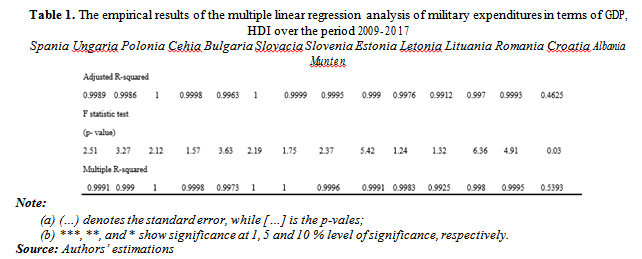Sustainability of military spending in EU and NATO member countries

Abstract
The research study highlights issues related to the correlation between military spending and the socio-economic development of EU and NATO member states. The impact of these expenditures within the Euro-Atlantic structures on economic development is highlighted on the basis of the multiple linear regression method, which uses backwards selective preoccupations, the average difference method, effective methods of analysis and approach that demonstrate the correlation between military expenditure variables and gross domestic product GDP/Loc), Human Development Index (HDI). The data used in the analysis is relevant for the EU and NATO member states for the period 2009-2017. Descriptors of military expenditure were considered to be the absolute amounts of “country-specific military expenditure, expressed in USD million according to the exchange rate and current price”, as stipulated by the International Peace Research Institute in Stockholm (SIPRI) 2017. As far as economic development descriptors are concerned, on-site GDP was used, provided by the International Monetary Fund (IMF) official databases on Gross Domestic Product and HDI provided by HDR Data Tools, which measures life expectancy, literacy, education, the standard of living and quality of life. The results highlight an optimal correlation in both directions of positive military expenditure against GDP and negative for HDI.
In most cases positive for HDI for Malta and unidirectional with negative effects relative to GDP in the USA, where the relationship is not strongly linear, and this leads to the need for research from a nonlinear perspective, opening up a new research horizon.
Table of Contents:
1. Introduction
2. Literature Review
3. Methodology and Data
4. Results and Discussions
5. Conclusions
1. Introduction
Over time there have been several controversies among the great actors on the political scene, the economy, and the military system. In order to identify the reasons behind the increase or decrease in the level of military spending in the Euro-Atlantic countries, the repercussions of the legislative changes in maintaining or increasing the defence budget of the EU and NATO member states on the economy, 2009-2017. There are many authors who have conducted such studies, highlighting the correlation between military spending and inflation, gross domestic product, investment, unemployment, their impact on economic growth, but the results are inconclusive and robust in many cases.
The results highlight a causal relationship between defense spending and economic growth during the 2009-2017 sampling period, and contradict the Keynesian aggression theory, indicating that the increase in defense budget allocation accelerates economic development. From an economic point of view, these results help us highlight the impact of military spending, which generates different positive or negative national effects on labor, capital, economic growth; it also influences the positive use of resources in the economic sector, defense spending as a percentage of GDP, the economy in general through real consumption expenditures, investments, equipment’s, exports, infrastructure over different sectors of activity for the analysed period.
The present research study could serve to stimulate debate on the role of the defense sector in the current context and would play a significant role in contributing to political decision-making aimed at increasing executive spending efficiency.
2. Literature Review
European integration, including in the field of defense, should no longer be taken into account only politically but as a strategic and economic necessity. Violent conflicts at the EU’s doorstep, increasing Europe’s exposure to hybrid warfare, cyber terrorism, and the disturbing distinction between internal and external threats are beginning to create an increasingly complex European security landscape. The literature provides inconclusive information on the relationship between military spending and socio-economic development, providing us with an analysis framework that still carries robust testing. We have noticed that most of the studies in this field are considered as a variable explanatory for the defense sector, military expenditures, and for economic development, economic growth is often used as an explanatory variable related to the gross domestic product level or its growth rate.
“Muhammad et al., (2017)”, using the generalized momentum (GMM) technique from 1972 to 2016, and Solow’s growth model with Harrod technology, finds the positive link between military spending and economic growth. Inequality is proving to be negatively associated with economic growth. “Chi Wei Su et al., (2018)” concluded that there is a positive bidirectional causality between economic growth and defense spending, suggesting that a larger defense budget increases economic growth and vice versa, using the causality test for the Bootstrap Granger test sample and estimating the window in 1952-2014 in China.
“Ying Zhang et al., (2016)” in his study, based on a panel cointegration analysis and impulse response function with data from several countries, used two time periods, 1998-2011 and 1993-2007 descriptive military expenditure and social welfare index. Empirical results show that military spending increases social welfare levels in developed countries, while the effect is ambiguous in emerging economies.
“Kyriakos Emmanouilidis & Christos Karpetis (2018)” in his work through a time series meditation, had as variables Military Expenditure and Economic Growth (GDP). In the case of the cointegrated series, the causality examination through the restricted ECM model revealed a unilateral causality between military spending and economic growth, unlike the simple VAR method that highlights the absence of any causal relationship. “Muhammad A., et al., (2018)” used the ARDL test in his work, underlining the results which highlight the fact that military spending in Pakistan has insignificant effects on the country’s economic growth. This paper contributes to the existing literature through the recently used data set (2009-2017) and the results obtained from the correlations between ME, HDI and GDP in EU and NATO member countries.
3. Methodology and Data
The data set used, from SIPRI 2017 databases of defense spending, the level of defense spending in GDP, using data reported by governments and official estimates for EU and NATO member countries on the 2009-2017 sample. Descriptive variables of military expenditure were considered to be the absolute amounts of “Country-Specific Military Expenditures in Million US
$ Depending on Current Exchange Rate and Current Price”, Military Expenditure as a Percentage of GDP, as provided by Stockholm International Peace Research Institute (SIPRI) database 2017.
In terms of economic development descriptors, GDP per capita was used, provided by the International Monetary Fund (IMF) official databases on Gross Domestic Product and HDI provided by HDR Data Tools. It measures life expectancy, the degree of literacy, education, the standard of living, and the quality of life for all countries, also called a standardized means of measuring the well-being of life in developed or developing countries.
4. Results and Discussions
Our research also proposes to study the impact of defense spending on growth and economic development in the Euro-Atlantic zone, on the basis of a multiple linear regression, where defense spending is variable response/dependent, and GDP, GDP per capita and HDI are predictive/independent variables. In all the cases studied, the analysis steps were statistically traced by removing the variables whose values are inconclusive until the optimal model was found – using the backward selection procedure method. The statistical calculations for statistical indicator coefficients were performed using the R. software.
The research methodology used in this respect is multiple linear regression. By linear regression, we have provided a possibility to predict its value (response variable) by means of the values of X1, X2, ..., Xm (prediction variables) by means of a linear function resulting from the least squares estimation.
In our study, statistical results for the model with all predictors, GDP, HDI takes into account the value of the variable dependent row, both in the control group (EU member countries) and in the study group (NATO member countries). Thus, the p-value is analysed for each variable and if it is very large for a predictor, it means that it is not significant for explaining the dependent variable, eliminating and continuing with the other two independent variables. It also takes into account the R-squared and Adjusted R-squared statistical indicators to conclude the optimal model of variables analysis. The multiple regression analysis procedures in the analysed paper starts with the estimation of the complete model and then, in a number of successive steps, the non-significant variables are removed from the model.
The results obtained for the optimal models provided by the multiple regression of the EU member countries according to the year of integration within the EU, as well as the optimal level of P-value and the coefficients of this independent variable against the dependent defense “defense expenditures”. The most noteworthy optimal values of predictors account for significance between 1,5 and 10% – materiality threshold, using the F test and the T test, and eliminating for each country the P-value predictor far beyond an acceptable error threshold (alpha = 0.1, 0.05, or 0.01) throughout the test, continuing with the model with the remaining predictors with optimal values, intercept or no intercept (Table 1).

The obtained results indicate that there is an optimal two-way correlation of positive military expenditures relative to GDP and negative in relation to HDI in most cases. It also indicates a positive one-way direction relative to GDP (Finland, Sweden, Norway), positive one-way relative to GDP per inhabitant (Latvia, Poland, Czech Republic, Romania, Spain, the Netherlands), one- way positive for HDI (Malta) and unidirectional with negative effects in relation to GDP for the USA. The results of the study indicate that a number of 15 countries have a one-way causal relationship between defense spending and GDP, of which only negative USA, the rest of the states (Belgium, Canada, France, Germany, Greece, Iceland, Italy, Turkey, UK, Austria, Cyprus, Finland, Norway, Sweden) with a correlation with positive effects. A causal relationship with positive effects between the dependent variable “defense expenditures” and HDI, with positive effects is noticeable in the countries of Denmark, Hungary, Luxembourg, Slovakia, Slovenia, Malta, the remaining 12 states are noted through a relationship unidirectional or bidirectional effects such as Albania, Bulgaria, Canada, Croatia, Estonia, Iceland, Lithuania, Montenegro, Portugal, Turkey, Austria and Ireland.
5. Conclusions
In this study, the conceptual arguments are empirically evaluated according to which the military sector is likely to influence the dynamics of the growth and development of the Euro Atlantic structures. Although the correlations between military expenditures and the descriptive variables of socio-economic development seem to be quite different for each analysed country, the results clearly indicate that the higher levels of budget allocations by governments produce a positive impact on GDP per capita and negative HDI in most of the analysed countries.
The results highlight the existence of an optimal two-way correlation of positive military expenditures relative to GDP and negative in relation to HDI in most cases. It also underlines the following: positive one-way direction relative to GDP for the set of countries Finland, Sweden, Norway; positive one-way relative to GDP on the one hand, for the set of countries Latvia, Poland, Czech Republic, Romania, Spain, the Netherlands; and one-way positive relative to HDI for Malta and unidirectional with negative effects on GDP in the case of the USA, where the relationship is not strongly linear, research from the perspective of a nonlinear relationship, opening up a new research horizon. We conclude that there will still be a pressure on the defense budgets of major players, as long as the threats continue to increase, mainly computer-related.
Authors:
GLONT [1]
DARMAZ-GUZUN [2]
PARA [3]
[1] PhD Stud. Oana Ramona Glont, Doctoral School of Economics and Business Administration, West University of Timisoara, Timisoara, (ROMANIA).
[2] PhD Stud. Adina Alexandra Darmaz-Guzun, Doctoral School of Economics and Business Administration West University of Timisoara, Timisoara, (ROMANIA).
[3] Assoc. Prof. PhD Para Iulia, Marketing and Economic International Relations, Faculty of Economics and Business Administration, West University of Timisoara, Timisoara, (ROMANIA).
Contributo selezionato da Filodiritto tra quelli pubblicati nei Proceedings “3rd International Conference Inclusive and Sustainable Economic Growth. Challenges, Measures and Solutions - 2019”
Per acquistare i Proceedings clicca qui.
Contribution selected by Filodiritto among those published in the Proceedings “3rd International Conference Inclusive and Sustainable Economic Growth. Challenges, Measures and Solutions - 2019”
To buy the Proceedings click here.



